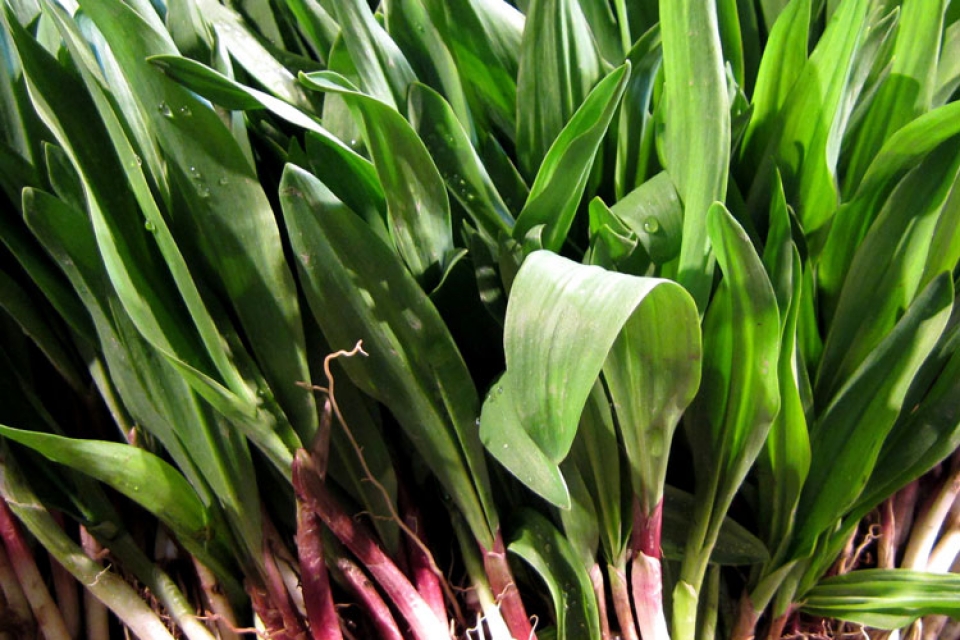A Sure Sign of Spring: Wild Ramps
Ramps, or wild leeks, are incredibly popular this time of year. After living through a winter full of root crops and squash, people are excited to eat something green, fresh, and foraged from the land. This excitement is also historical – ramps were traditionally an exciting spring addition to plates of Native Americans and early colonists as well. You or your parents may also remember their parents and grandparents going out to harvest ramps and bring home buckets full. In the American South, you can still find festivals celebrating the arrival of ramps to this day. The popularity of the ramp is not abating, but is in fact growing. Due to a rapid increase in popularity throughout the country starting in the 1990s as chefs began to highlight this local ingredient, there has been disagreement over best management practices to ensure that ramp populations are protected and not overharvested.
There are generally two harvesting methods: harvesting the whole plant (bulb and all) or just harvesting the leaves of the plant. There is not a consensus on which harvesting method is best. The most common method is harvesting the entire plant. When the entire plant is harvested, the bulbs should be dug up gently to minimize disturbance, and it is good practice to take only a few mature plants from each clump and to always leave more than you take to ensure survival and reproduction of the colony. The other way to harvest ramps is by picking or cutting the leaves from the plant. Generally, it is recommended to take less than 20% (or less!) of the leaves from a clump of ramps to ensure survival of the colony.
Ramps propagate in two ways. The most efficient way is through rhizomes under the soil. The second way is through seed. It typically takes a ramp plant 5-7 years to produce seeds and the seeds take 6-18 months to germinate. This is why some people feel it is more sustainable to just harvest the leaves and leave the bulbs undisturbed. The leaves work great for fresh eating and cooking. If the ramps you get have bulbs, you can eat the bulbs fresh or cooked as well, but they don’t add much additional flavor. Instead, try pickling the bulbs!
Sustainable harvesters will generally avoid harvesting entire plants from the same clump for at least 5 years to let the colony rebound. Concerns related to overharvesting include overall population decline, spread of invasive species (ramps suppress competitors, however when ramp population density decreases, the opportunity for invasive species to spread increases), and trampling of sensitive forest plants.
Because of ramps’ popularity, there has been increasing concern about the sustainability of their harvest. Ramps grow as far south as Georgia and as far north as Quebec, but population strength varies. In Quebec, ramps are listed as a threatened species and harvesting has been banned since 1995. Harvesting was banned in Great Smokey Mountains National Park in 2004. In New York and Vermont, ramp harvesting is not currently limited.
We receive questions from curious customers about our wildcrafting vendors and their practices. We do not accept walk-in sales of wildcrated items. We work hard to establish long-term relationships with our wildcrafting vendors to ensure that they are practicing ethical and sustainable harvesting, and we ask each of our vendors to sign our “Wildcrafter’s Pledge.” By doing so, the vendors pledge to:
- Weigh the impact they have on the land before harvesting.
- Harvest only healthy plants and fungi that are not contaminated by roadways, railroad tracks, industrial and agricultural runoff, urban areas, sewage zones, oil spills, and places heavily sprayed with pesticides, herbicides, etc.
- Process the harvest as soon as possible after it has been picked.
- Never harvest more than I can process.
- Use mesh bags when harvesting mushrooms to ensure spore distribution and encourage mycelium growth.
- Know how to make accurate plant identification to ensure the safety, health, and wellness of the general public.
- Never harvest rare or endangered species (for example: American Ginseng and Wild Echinacea).
- Leave more than I take.
- Respect the environment that provides us with these gifts.
We know the vendors we work with forage in a responsible and respectful manner to ensure that the wild populations of these items stay constant or increase. If you have additional questions about our wildcrafting vendors and their practices, please ask to speak to one of our Produce Buyers the next time you are in the store.
Not sure how to use ramps? Try these recipes:
Ramps and Eggs
Sauteed Morels with Ramps and Goat Cheese
Ramp Bruschetta
Pesto with Wild Leeks and Pistachios
